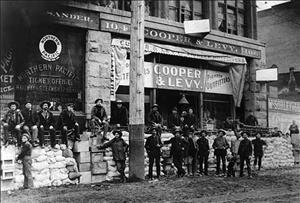On July 17, 1897, the steamship Portland arrived in Seattle from Alaska with 68 miners and a cargo of “more than a ton of solid gold” from the banks of the Klondike River in Canada's Yukon Territory. This set off a rush to Alaska and an era of prosperity in King County that lasted for more than a decade
Seattle residents woke to the sound of newspaper boys hawking an extra edition of the Seattle Post-Intelligencer with the following headline:
"GOLD! GOLD! GOLD! GOLD!
Sixty-eight Rich Men on
the Steamer Portland
STACKS OF YELLOW METAL!
Some Have $5,000, Many Have More
A Few Bring Out $100,000 Each
THE STEAMER CARRIES $700,000"
The article began, “At 3 o’clock this morning the steamer Portland from St. Michael [Alaska] for Seattle, passed up the Sound with more than a ton of solid gold aboard.” The Post-Intelligencer scooped the other Seattle newspapers when its reporter, Beriah Brown Jr., took a tug from Seattle to the Strait of Juan de Fuca and waited for the Portland to pass by. Brown was the son of Beriah Brown (1815-1900), a former P-I editor and Seattle mayor.
The tug, Sea Lion, met the Portland off Cape Flattery, and Brown embarked the inbound steamer and interviewed some of the gold miners. Then the tug headed full speed to Port Townsend. Brown ran to the telegraph operator's home and roused him and wired the story to the Post-Intelligencer: "A ton of gold is coming to Seattle."
The Post Intelligencer issued the extra edition before the Portland docked. The news spread fast and by 6 a.m. a crowd of more than 5,000 greeted the Portland when she tied up to Schwabacher Wharf.
Among the Portland’s passengers were:
- William Stanley, a former Seattle bookseller, and his son, who went to the Yukon valley in 1896 and returned with from $90,000 to $112,000 in gold dust and nuggets;
- Frank Phiscator from Baroda, Michigan, who spent just three months in Alaska and disembarked the Portland with from $96,000 to $120,000 in gold;
- T. J. Kelly, a Tacoma resident, who returned from the Klondike with $10,000 in gold;
- Clarence Berry, a Fresno, California, fruit farmer and his wife, who unloaded off the Portland about $135,000 in gold dust and nuggets.
After all the gold was weighed the Post-Intelligencer’s one-ton estimate turned out to be too low. The actual amount unloaded from the Portland was two tons.
People were immediately infected with Klondike Fever. By 9:30 a.m. the city’s downtown streets were so crowded with people that some streetcars were forced to stop running. Seattle Times reporters, longshoremen, and others quit their jobs on the spot and looked for passage to Alaska.
William D. Wood (1858-1917), mayor of Seattle, who was attending a convention in San Francisco, telegraphed his resignation and headed to Alaska without even stopping in Seattle. Local merchants quickly sold out of miners' supplies. The fever spread across the United States quicker than any virus. Within 24 hours, 2,000 New York residents attempted to buy tickets for the Klondike, unsuccessfully because the locals had already bought them. Within 10 days, 1,500 persons departed Seattle for the gold fields. The rush was on.

